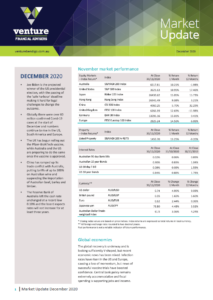The Pulse
- Joe Biden is the projected winner of the US presidential election, with the ‘safe harbour’ deadline making it hard for legal challenges to change the outcome.
- Globally there were over 60 million confirmed Covid-19 cases at the start of December and numbers continue to rise in the US, South America and Europe.
- The UK has begun rolling out the Pfizer-BioNTech vaccine, while Australia and the US are preparing to do the same once the vaccine is approved.
- China has ramped up its trade conflicts with Australia, putting tariffs of up to 200% on Australian wine and suspending the importation of Australian beef, barley and timber.
- The Reserve Bank of Australia left the cash rate unchanged at a record low 0.10% and the board expects rates will not increase for at least three years.
Australia
Australia’s economic recovery has found solid footing, underpinned by low Covid-19 case numbers nationwide and news of successful vaccine trials.
Global economies
The global recovery is underway and is looking sufficiently V-shaped, but recent economic news has been mixed. Infection rates have risen in the US and Europe, causing a loss of momentum, but news of successful vaccine trials have boosted confidence.
US
As coronavirus case numbers continue to rise, additional fiscal stimulus is firmly back on the agenda. The US economy has rebounded strongly, but recent economic data has dissapointed.
Europe
Europe’s recovery has set in, even as the region battles resurgent coronavirus numbers and national governments implement new post-lockdown restrictions ahead of the festive season.
China
China is preparing for a large-scale rollout of its own domestically developed coronavirus vaccines. At least five vaccines from four producers are being tested in more than a dozen countries including Russia, Egypt and Mexico, while around one million Chinese health care and other workers deemed at high risk have already received the vaccine.
Asia region
Japan’s GDP rebounded by an annualised 21.4% in the September quarter (surpassing expectations of 18.9%) following a revised 28.8% contraction in the prior quarter. The main driver was net external demand, which contributed more than half of the growth, while private consumption also added to the result, returning to growth for the first time this year.
